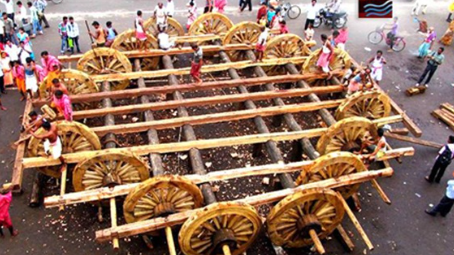

Bhubaneswar: The magnificent chariots that carried Lord Jagannath, Balabhadra, and Subhadra—crafted with meticulous care over months and costing lakhs of rupees—are methodically dismantled and destroyed. To the uninitiated, this might seem wasteful, even sacrilegious. But embedded within this annual destruction lies one of Hinduism's most profound philosophical teachings: the concept of impermanence.
"Every year, we build these chariots knowing they will be destroyed. This is not destruction—it is liberation," explains Gajapati Dibyasingha Deb, the titular king of Puri who performs the ritual sweeping of the chariots. "The moment we become attached to the material, we lose sight of the eternal."
The destruction follows a sacred timeline. After the Bahuda Yatra (return journey), the chariots remain stationed for specific rituals. The wood is then distributed among devotees for cooking sacred meals, crafting religious artifacts, or used in temple kitchens. Nothing is wasted; everything transforms.
Dr. Ratnakar Mohapatra, a renowned scholar of Jagannath culture at Utkal University, elaborates: "The chariot destruction is perhaps the most visible manifestation of the philosophical concept of 'Anicca' or impermanence. What Buddhism calls the fundamental characteristic of existence, Hinduism demonstrates through this living tradition."
The philosophy resonates powerfully in contemporary times. Social media users have begun drawing parallels between the chariot destruction and modern life's attachments. A viral tweet by spiritual teacher @VedantaWisdom reads: "We spend months building careers, relationships, dreams—only to see them change. Rath Yatra teaches us: create with devotion, release with grace."
Netizen Priya Sharma from Delhi posted on Instagram: "Watched the chariot dismantling live stream. Crying because I realized how much I cling to things that are meant to be temporary. This is therapy, not destruction."
The teaching extends beyond material possessions. Sevayat (servitor) Raghunath Das, whose family has served the temple for eight generations, offers a deeper perspective: "My grandfather used to say, 'Beta, even these bodies are chariots for the soul. One day, they too will return to dust. The Lord's journey continues, but the vehicle changes.'"
Each Rath Yatra chariot costs approximately ₹15-20 lakhs to construct. The Nandighosa (Jagannath's chariot) alone uses 4,200 wooden pieces. "From a material standpoint, it seems like enormous waste," admits Krushna Chandra Pratihari, chief architect of the chariots. "But spiritually, it's an investment in collective awakening. How do you price enlightenment?"
The wood, primarily from sacred trees, is considered blessed after carrying the deities. Devotees queue for hours to receive even small pieces. "I use the blessed wood to cook my family's daily meals," says Meera Biswal, who traveled from Bhubaneswar. "It's not just wood anymore—it's divine grace that has served its purpose and now serves mine."
The destruction ritual bears striking resemblance to Tibetan Buddhist sand mandala ceremonies, where monks spend weeks creating intricate designs only to sweep them away upon completion. Dr. Bijoy Misra, a comparative religion scholar at Harvard, notes: "Both traditions understand that the act of creation itself is sacred, not the created object. The chariot serves its purpose in the moment of the journey, not in its preservation."
This synthesis of Hindu and Buddhist thought isn't coincidental. Historical evidence suggests that Jagannath worship incorporated Buddhist elements during the 8th-12th centuries when Buddhism flourished in Odisha. "The concept of Buddha nature and Hindu atman find common ground in the impermanence teaching," explains Dr. Misra.
The philosophy has found new expression in the digital age. YouTube spiritual teacher Gaur Gopal Das, who has 4.2 million subscribers, recently said: "We update our phones every year, change our clothes seasonally, but struggle to let go of grudges, failed relationships, and past hurts. The Rath Yatra chariot teaches us that even the sacred can be released with love."
Young devotees are creating TikTok videos explaining the concept. A particularly popular video by @SpiritualGen explains: "The chariot isn't destroyed—it's transformed. The wood becomes cooking fuel, the iron becomes temple utensils, the fabric becomes prayer flags. Nothing truly dies; everything evolves."
For those who build and maintain the chariots, the philosophy is lived experience. Master craftsman Harekrushna Maharana, 67, who has built chariots for four decades, reflects: "When I was young, I felt sad seeing my year's work dismantled. Now I understand—the chariot's job is to carry God, not to last forever. When the journey ends, the chariot's purpose is fulfilled."
His apprentice, 28-year-old Subash Maharana, adds: "My generation initially questioned this practice. Why not preserve them as heritage? But working with the blessed wood throughout the year, I've learned that preservation would actually be selfishness. The wood wants to serve again, in new forms."
As another Rath Yatra concludes and the magnificent chariots face their inevitable dismantling, the timeless lesson endures: true spirituality lies not in grasping but in graceful letting go. In a world increasingly obsessed with permanence—from Instagram posts to corporate legacies—the annual destruction of Puri's chariots stands as a powerful reminder that impermanence isn't life's flaw but its most beautiful feature.
The chariots die so that their wood may live again. The ritual ends so that the teaching may begin anew. In this sacred cycle of creation and dissolution, devotees find not loss but liberation—the very essence of spiritual awakening.
As the ancient Sanskrit saying goes: "सर्वं खल्विदं ब्रह्म" (Sarvam khalvidam brahma) - all this is indeed Brahman, eternal and ever-changing, like the chariots that carry the divine and return to dust, only to be reborn with each rising sun.